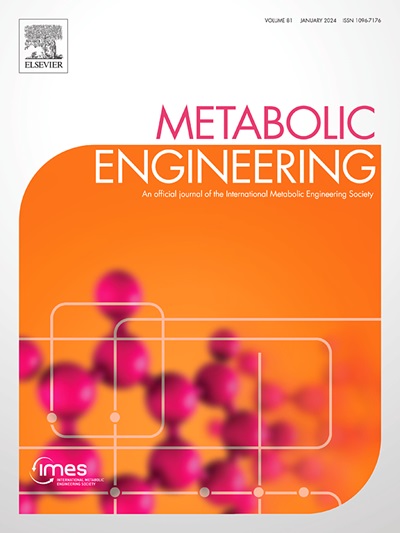通过重新连接酿酒酵母脂滴中的后角鲨烯模块,超量产生 7-脱氢胆固醇。
IF 6.8
1区 生物学
Q1 BIOTECHNOLOGY & APPLIED MICROBIOLOGY
引用次数: 0
摘要
脂滴(LDs)是一种特殊的细胞器,可储存中性脂质,以减少脂毒性对细胞的负面影响。然而,许多中性脂质是合成甾醇和复杂萜类化合物的前体,这种封存往往极大地限制了甾醇和复杂萜类化合物的有效生物合成。本研究以酿酒酵母(Saccharomyces cerevisiae)中 7-脱氢胆固醇(7-DHC)的合成为例,揭示了 LD 封存对代谢产物高效合成的阻碍机制,发现 LD 可以封存大量的角鲨烯(7-DHC 的前体),有效阻止其进入后角鲨烯途径。在此基础上,在 LDs 上重建了缬氨酸后途径,结果 7-DHC 滴度增加了 28.7%,达到 684.1 毫克/升,而角鲨烯滴度则降低了约 97%。随后,三酰甘油降解途径被削弱,以释放鳞片内的储存空间,同时酯化途径被加强,以引导 7-DHC 在鳞片内的储存,这进一步增加了 7-DHC 的产量,达到 792.9 毫克/升。最后,通过降低 NADH/NAD+ 比率来缓解氧化还原失衡,7-DHC 滴度在摇瓶中达到 867.6 mg/L,在 3 L 生物反应器中达到 5.1 g/L,这是迄今为止报道的最高滴度。总之,这项研究为了解低密度脂蛋白在固醇合成中的重要作用提供了新的视角,并为构建高效合成固醇化合物的细胞工厂提供了一种新的策略。本文章由计算机程序翻译,如有差异,请以英文原文为准。
Hyperproduction of 7-dehydrocholesterol by rewiring the post-squalene module in lipid droplets of Saccharomyces cerevisiae
Lipid droplets (LDs) are specialized organelles that store neutral lipids to reduce the negative effects of lipotoxicity on cells. However, many neutral lipids are precursors for the synthesis of sterols and complex terpenoids, and this sequestration often greatly limits the efficient biosynthesis of sterols and complex terpenoids. In this study, taking 7-dehydrocholesterol (7-DHC) synthesis in Saccharomyces cerevisiae as an example, we revealed the blocking mechanism of LD sequestration on the efficient synthesis of metabolic products and found that LDs can sequester a significant amount of squalene, the precursor of 7-DHC, effectively preventing it from being directed toward the post-squalene pathway. Based on this, a post-squalene pathway was reconstructed on LDs, which resulted in a 28.7% increase in the 7-DHC titer, reaching 684.1 mg/L, whereas the squalene titer was reduced by approximately 97%. Subsequently, the triacylglycerol degradation pathway was weakened to release the storage space in LDs, and the esterification pathway was concurrently strengthened to guide 7-DHC storage within LDs, which further increased 7-DHC production, reaching 792.9 mg/L. Finally, by reducing the NADH/NAD + ratio to alleviate the redox imbalance, the 7-DHC titer reached 867.6 mg/L in shake flask and 5.1 g/L in a 3-L bioreactor, which is the highest reported titer to date. In summary, this study provides new insights into the important role of LDs in sterol synthesis and offers a novel strategy for constructing cell factories for the efficient synthesis of sterol compounds.
求助全文
通过发布文献求助,成功后即可免费获取论文全文。
去求助
来源期刊

Metabolic engineering
工程技术-生物工程与应用微生物
CiteScore
15.60
自引率
6.00%
发文量
140
审稿时长
44 days
期刊介绍:
Metabolic Engineering (MBE) is a journal that focuses on publishing original research papers on the directed modulation of metabolic pathways for metabolite overproduction or the enhancement of cellular properties. It welcomes papers that describe the engineering of native pathways and the synthesis of heterologous pathways to convert microorganisms into microbial cell factories. The journal covers experimental, computational, and modeling approaches for understanding metabolic pathways and manipulating them through genetic, media, or environmental means. Effective exploration of metabolic pathways necessitates the use of molecular biology and biochemistry methods, as well as engineering techniques for modeling and data analysis. MBE serves as a platform for interdisciplinary research in fields such as biochemistry, molecular biology, applied microbiology, cellular physiology, cellular nutrition in health and disease, and biochemical engineering. The journal publishes various types of papers, including original research papers and review papers. It is indexed and abstracted in databases such as Scopus, Embase, EMBiology, Current Contents - Life Sciences and Clinical Medicine, Science Citation Index, PubMed/Medline, CAS and Biotechnology Citation Index.
 求助内容:
求助内容: 应助结果提醒方式:
应助结果提醒方式:


